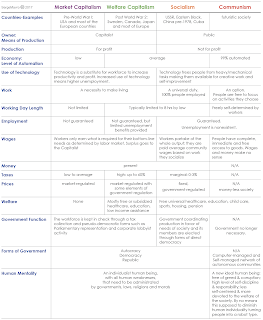“Communism sounds fantastic on paper. Why did it fail in reality?”
Communism
is a futuristic concept. It didn’t fail since it never existed in
reality. And of course people get mixed up Stalin’s version of socialism
with Marx’s theory of communism. There are many misconceptions.
Communism, according to Marx, is:
- Stateless, classless and money-less society (look ma, no taxes!).
It will probably have some sort of e-governance. - All means of production are publicly owned (modern example: the New York City metro-subway system is publicly owned)
- Highly efficient and fully automated economy with very few human workers employed.
- Distribution principle: "from each according to their ability, to each according to their need", which means unlimited consumption of free goods and no compulsory labor (post-scarcity economy). In other words, the “unlimited consumption” means most goods can be produced in great abundance with minimal human labor needed, so that they become available to all freely:
- The supply of goods would always exceed the demand.
- This principle of consumption is unconditional and it requires NO payment with your labor/money. The money are obsolete
- Human evolution into New Man: a new ideal human being, who believes in individual responsibility before society, who is free of greed and corruption. The new man would be naturally developed by the means of education and enlightenment.
It
was an absurd nonsense proposition that Russia and China could bypass
capitalism jumping from feudalism directly to socialism. After the 1917
revolution Lenin realized that bolsheviks are going too fast, so in 1921
he established New Economic Policy
(NEP), which he described as state-regulated capitalism, while
socialized state enterprises would operate on a profit basis. Lenin
considered the NEP as a strategic retreat from socialism to last several
decades, saying "we are taking one step backward, to take two steps
forward later". Stalin saw NEP as a betrayal of communist principles,
abandoned NEP after Lenin’s death. Eventually, at the end of 20th
century both Russia and China switched back to state-regulated
capitalism anyway.
Many people got scared by
the concept of "Dictatorship of the proletariat". Keep in mind this is a
figure of speech, to indicate revolutionary transition from capitalism
to socialism. In the 19the century the revolution was the only option. I
believe this concept is obsolete and the future the transition can
happen evolutionary and it is slowly happening now, which is inline with
a more modern Libertarian Marxism, a broad range of philosophies that emphasize the anti-authoritarian aspects of Marxism.
Today humanity is not ready for communism for 2 reasons:
- The economy and technology are not developed enough to provide unlimited consumption and full automation.
- New ideal human being has not been developed yet by society and evolution. Such process is continuously happening though; the example of this evolution is the 200-year progress from slavery to modern civil rights.
Specific differences of economic systems:
As you can see, communist labor is not wage-based. Wage labor has long before Marx been compared to slavery:
- Cicero wrote in 44 BC that "vulgar are the means of livelihood of all hired workmen whom we pay for mere manual labor, not for artistic skill; for in their case the very wage they receive is a pledge of their slavery".
- Aristotle made the statement that "the citizens must not live a mechanic or a mercantile life (for such a life is ignoble and inimical to virtue), nor yet must those who are to be citizens in the best state be tillers of the soil (for leisure is needed both for the development of virtue and for active participation in politics)", often paraphrased as "all paid jobs absorb and degrade the mind".
By
the way, have you thought what is going to happened when the capitalist
economy will achieve total industrial automation, equals to total
unemployment? Services can be automated just as well. Imagine even now
they already have robotic surgeries. Eventually humanoid robots could do
anything. All these unemployed people will have no means for honorable
existence. In the world where, for instance, 10% of people own 100% of
means of production and the other 90% are unemployed there are only two
scenarios both basically leading to communism:
- Peaceful Scenario: 10% of people will voluntarily provide honorable welfare for the rest of the 90% people who are unemployed (we already observe Basic unconditional universal income pilots)
- Revolution Scenario: 90% of unemployed people will forcefully expropriate means of production into the public ownership and redistribute income equally
You
can’t expect communism succeeding today. We making small steps forward
in technology and civil rights. We are nearly at the barbarian stage of
history: look, only recently in 1971 women in Switzerland gained the
right to vote and in 1967 interracial marriage in U.S. was finally
legalized:
Perhaps,
we will arrive at a time when science and technology can provide
abundance to all people. It would no longer be necessary to perpetuate
our old and outworn profit system. If we are genuinely concerned about
the environment and our fellow human beings, if we really want to end
wars, crime, poverty and hunger, we must consciously reconsider the
social processes that led us to a world where these factors are common.
According
to Marx, the aim of communism is to encourage an incentive system no
longer directed toward the shallow and self-centered goals of wealth,
property, and power. These new incentives would encourage people toward
self-fulfillment and creativity, both materially and spiritually.
If
communism is not a utopia, it may take a few hundreds of years to
achieve the communism. But hey, we, humans, have plenty of time. Human
civilization has been around for just few thousand years. This is a baby
age. There are 2–3 billions years ahead, until our planet will be burnt
by the Sun




Comments
Post a Comment